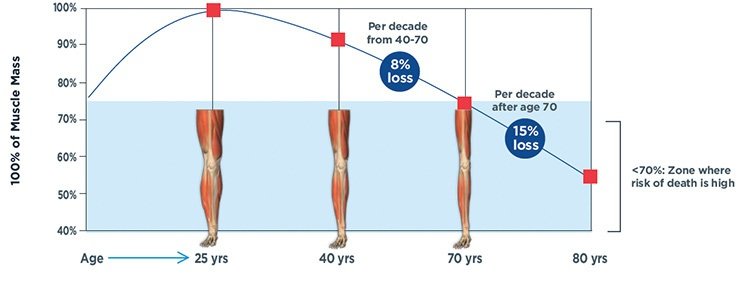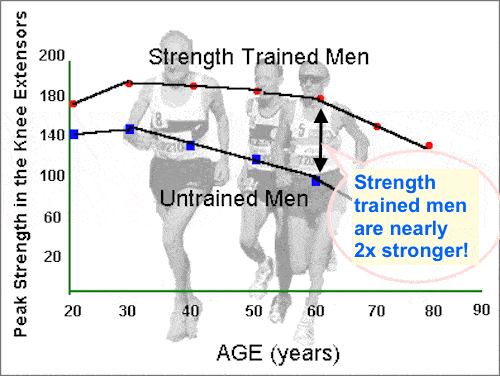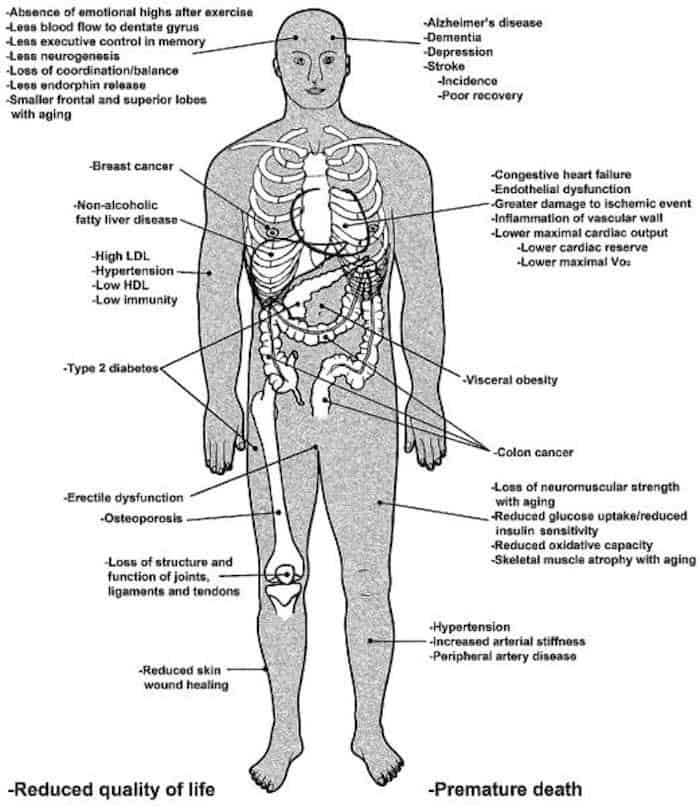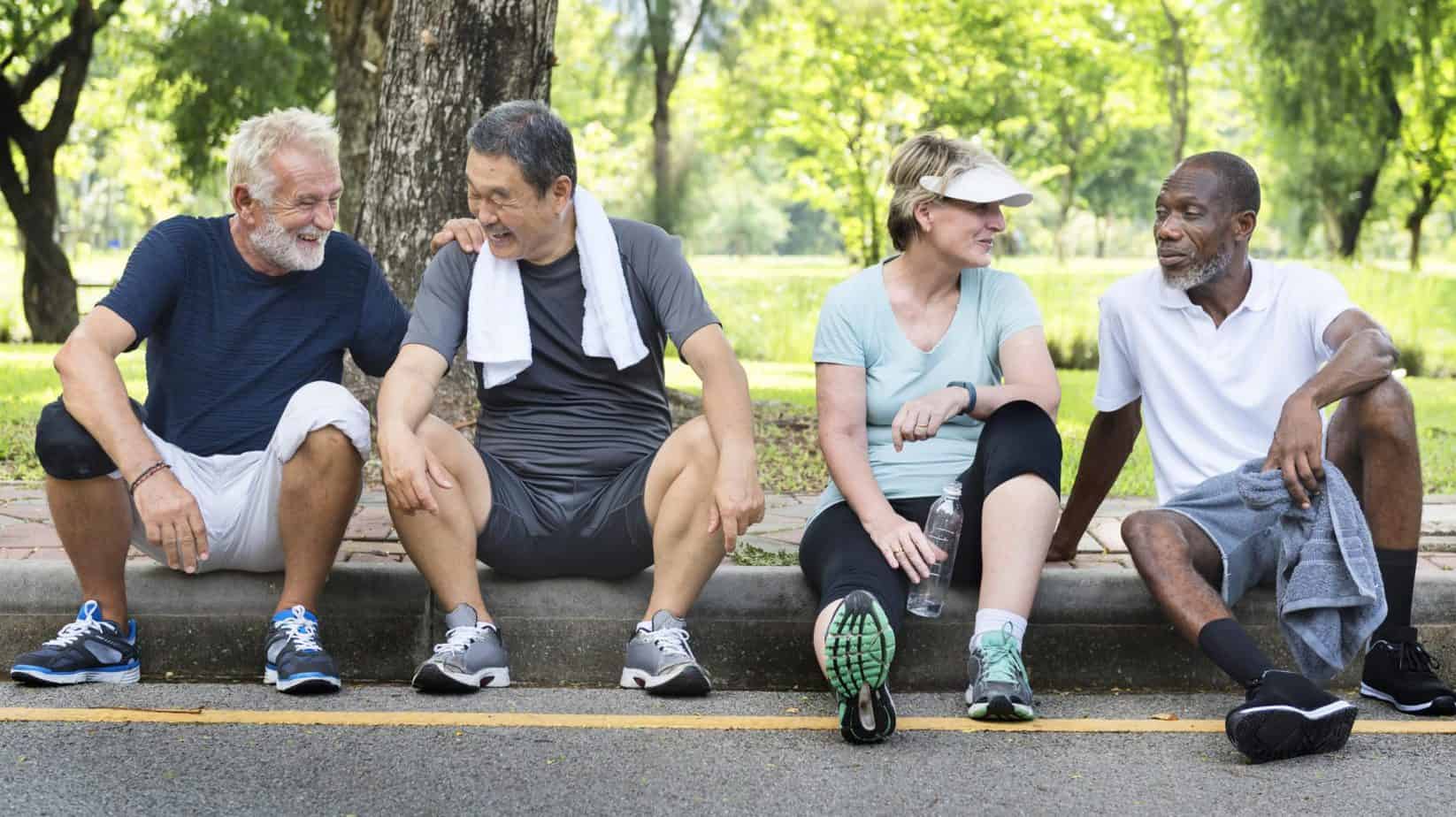Why You Must Exercise for Longevity and How To Do It
You must exercise for longevity. It’s as simple as that. If you want a long, strong and healthy life, you must exercise. Otherwise, your muscles atrophy, your brain goes senile and you get chronically ill. Read, watch the video and go call a friend.
IT’S NOT a pretty picture.
Earlier this week on June 28th, 2018, the Center for Disease Control published a paper reporting that only 20% of adults United States get enough aerobic and muscle-strengthening exercise to support health and vigor, because:
“Regular participation in physical activity lowers the risk of many chronic conditions, disability, and mortality,” says the agency.
I bet that low number is even lower among the middle-aged.
Why are Americans — like much of the industrialized world — getting less and less fit, and more and more fat?
The CDC’s take on the matter:
“The United States now has a service economy that requires minimal physical activity from a majority of workers who perform work that is largely sedentary.” (1)
Which is why I wrote about the dangers of sitting too much. Which is why I will urge you to get up and move in specific ways. Which is why I’m going to show you how to begin an exercise program that you can sustain.
The bottom line:
You must exercise for longevity!
In this article, we’ll cover:
- Why to exercise for longevity requires fighting against Sarcopenia;
- Why your brain loves the gym;
- Why to exercise for longevity means you come resistant to chronic illness;
- Why exercise for longevity begins with Mobility Training;
- Why cardio exercise needs to include Anaerobic and Aerobic conditioning;
- Why resistance training is the best exercise for longevity; and
- The Push, Pull and Lever type exercises that you need for a long and strong life.
Let’s dig in…
Exercise Helps Prevent Muscle-wasting, Cognitive Decline and Chronic Illness
It’s bad enough if you’re a young man or woman and don’t regularly exercise or take part in vigorous activity. But if that’s the case and you’re middle-aged, it is disastrous.
Here are three BIG reasons why you must exercise for longevity:
1. Resist Sarcopenia
As WebMD puts it, you start losing muscle during your thirties due to age-related sarcopenia, which is muscle loss.
Physically inactive people can lose as much as 3% to 5% of their muscle mass each decade after age 30. Even if you are active, you’ll still have some muscle loss, unless that activity focuses on resistance training exercises that keep up or build muscle.
Resistance training can help your neuromuscular system, hormones, mobility, balance, muscularity and strength. It also can improve an older adult’s ability to convert protein to energy in as little as two weeks.
Check out this illustration that shows an 8% loss in muscle mass per decade between ages 40 to 70 (three points higher than the CDC estimate), and a 15% loss thereafter (source):
But it doesn’t have to go down like that. Check out the next graph, which shows that startling divergence between strength-trained men and those untrained. (The same would be largely true for women.) Note that by age 60, the strength of men who do not strength train is nearly half of those who do!
As you age, which line in the above graph do you want to tread?
2. Resist Deteriorating Brain Health
You need to exercise for longevity because regular exercise changes the brain to improve memory and thinking skills, says Harvard Medical School. At at time when researchers say one new case of dementia is detected every four seconds globally, surely it makes a lot of sense to do what needs doing to help make sure that you’re not one of them.
The direct benefits of exercise are derived from its ability to cut insulin resistance, reduce inflammation, and stimulate the release of growth factors—chemicals in the brain that affect the health of brain cells, the growth of new blood vessels in the brain, and even the abundance and survival of new brain cells, says Harvard.
Indirectly, exercise improves mood and sleep, and reduces stress and anxiety. Problems in these areas often cause or contribute to cognitive impairment.
 (source)
(source)
Yes, your brain loves exercise. That’s not the hurdle to clear. The hurdle to clear is your attitude toward consistent, vigorous exercise.
To help you clear that hurdle, next up is one more motivating reason to jump.
3. Resist Chronic Disease
In this study, Frank W. Booth, Ph.D., Christian K. Roberts, Ph.D., and Matthew J. Laye, Ph.D. did a thorough review of the relationship between the lack of exercise and chronic disease.
Their conclusions:
- Chronic diseases are major killers in the modern era.
- Physical inactivity is a primary cause of most chronic diseases.
- You must exercise for longevity.
You could spend all day picking through the study, but the authors kindly gave us this:
Sure seems that a body needs a lifetime of exercise to live a good lifetime.
Recruit A Buddy (Or Two)
Now, perhaps given all that you read so far you’re sitting here thinking, Gee, I really should begin an exercise regimen, but unfortunately the odds are that you will not. If you’ve never exercised before and you’re not doing so now, you’re unlikely to do so tomorrow.
The only chance you have to prove me wrong is to get up pick up the phone call two people could persuade to exercise regularly with you, because they exercise regularly and are willing to be the wind at your back.
Call them, tell them you want to start a regular exercise program and set a date to begin with their help. If you don’t have such friends, set an appointment with a trainer. A local gym can recommend one.
The rest of this piece will give you some ideas how to put together an exercise regimen based on your needs and interest.
To Exercise for Longevity, Begin With Mobility
Begin with Mobility simply because it’s the restricted range of motion, tightness or injury to your joints, muscles and tendons that makes us frail as we age. Begin with mobility because you want to prepare your body for the stress it will initially endure after you take on cardio and resistance training.
Unless you actively maintains the suppleness of their soft tissue, your body will contract, shorten and bend forward as you age.
In my “Warm Up and Mobility” article, I show you several routines that I grabbed from Youtube. Here’s the first of them:
Don’t let yourself get turned off if the mobility exercises demonstrated in the video seem too hard or the routine is too long for you. Get creative! Amend the exercises to fit your ability and just do what you can. But do it daily, either by itself or before your cardio or resistance training.
Do Cardio = Anaerobic + Aerobic Training
The website is called Bodybuilding.com, but exercise trainer and author, Shannon Clark, lets its readers know that fitness requires more than muscle — cardio exercises should be part of the mix.
“Cardio” refers to cardiovascular exercise, which is exercise that raised your heart rate and increases blood circulation.
Ms. Clark cites these five benefits derived from cardiovascular exercise:
(1) Improved heart health. It’s a muscle just like your bicep and needs to be exercised to keep up its health and capacity.
(2) Increased metabolism. Metabolism is the process by which your body converts what you eat and drink into energy. Generally speaking, the higher your metabolism, the more fuel (food and drink) you “burn” and the easier it is to maintain or lose weight. Intense interval sprints (also known as HIIT) increase metabolism the most, but so does steady state cardio, such as walking (fast), jogging, riding a bike or swimming at a constant state that can be maintained for 20 minutes or more.
(3) Improved hormone profile. Cardiovascular exercise can influence your hormones. It can increase the “feel good” hormones, such as endorphins, dopamine and serotonin that can help ease symptoms of depression and fatigue, as well as releasing hormones that decrease the appetite.
(4) Improved recovery capacity. Moderately paced cardio (as opposed to HIIT) can improve (decrease) your recovery time after exercise. If you have just performed a hard session in the gym, hopping on the treadmill for a walk or light jog will help to remove some of the by-products created by anaerobic or resistance training, such as lactic acid.
(5) Blood sugar management. Cardiovascular exercise increases your muscle’s ability to use glucose. Those who exercise regularly tend to have better control of their blood sugar. Given that the CDC estimates that nearly one-third of Americans have diabetes or prediabeties (100 million!), controlling blood sugar is extremely important. (2)
As we get older, we must be kinder to our bodies, and that includes not torturing our ankles, knees and hips with the pounding they get from jogging on hard surfaces. Thankfully, there are many other options that can rev up your heart and respiration in spurts (anaerobic) or keep them at a sustainable rate for 20 minutes or more (aerobic).
Here are five things you can do for anaerobic conditioning:
- Burpees
- Circuit training with weights (fast pace)
- Sprinting up stairs (less pounding than running on flat ground)
- Waking fast up hills with a backpack or weight vest
- Sprinting on flat roads or up hills on a bike
Read, HIIT It Hard For Your HGH Boost and learn how to do three anaerobic workouts in my article, Your 3 Minute Nitric Oxide Workout Prep for High Intensity Interval Training.
Here are five things you can do for aerobic conditioning:
- Walk fast
- Jog on soft ground
- Bicycle
- Swim
- Circuit training with weights (slow, steady pace)
Next up is a video by Kinesiologist, Jeremy Ethier, who will show you a few examples of steady state and HIIT-type cardio and suggest how to integrate them both into your exercise regimen.
Jeremy explains things very well, don’t you think?
Resistance Training, The Ultimate Exercise for Longevity
Resistance training refers to moving under resistance, such as squat or push-ups. In either case the load (resistance) is your own body weight, or added weight such as a bar bell or dumb bell.
Although certain anaerobic exercises add resistance to your training (circuit training with weights, for instance), the best way to wave your middle finger at sarcopenia (muscle wasting) and to exercise for longevity is to build muscle and strength via the resistance of your own body and/or with weights.
According to new research out of University of Sydney, strength-based workouts may be just as important as aerobic ones.
The study, published in the Journal of Epidemiology, looked at the exercise habits of over 80,000 people over time. Here’s what they discovered about people who performed strength-based training:
- They had a 23% reduction in risk of premature death by any means; and
- They were 31% reduction of cancer-related death. (Interestingly, aerobic exercise had almost no impact on cancer death rates.) (Read more here.)
The aim is not to become muscle-bound, but to become functionally strong, keep up muscle if you have any, or to build some if you don’t.
Functional strength is needed to support your ability to move yourself in the world and deal with whatever you might meet, such as picking something heavy up and carrying it up a flight of stairs, even if that something is your very own body.
When you gather together with those buddies of yours you’re going to call, you can all check the various videos I’ve collected in my six-part series, The Functionally Fit Fast Workout, for which I’m the poster child:
For those of you who don’t wish to wade through my six-part series, make sure your resistance training includes this:
- Pushing exercises, such as overhead presses, push-ups and squats
- Pulling exercises, such as dead lifts, chin-ups, rows and leg lifts (for abs).
- Lever exercises, such as the Single Leg Deadlift
I grabbed some examples for you from Youtube.
Certified Nutritionist Derek Simnett organizes his workouts into “push” and “pull” days, so let’s take a peak at how he does them in the first two videos, but first, this:
Derek is advanced, and you’re probably not. Don’t get turned off by thinking that what he’s doing is too hard for you. Simply modify what he does to fit you. If you can’t do a regular push-up, do it on your knees. If that’s too difficult, stand up, lean against a wall and press yourself away from it.
Pushing Exercises
Pulling Exercises
Lever Exercise
Your butt’s gonna love this one.
Your Training Schedule
The three things that will inevitably guide your schedule is:
- Your recovery time;
- What you willing to do; and
- When are you willing to do it.
There’s no point in coming up with some ideal amount of time and sequencing for all this exercise if it doesn’t fit with your schedule and what you willing to do. The only way exercise can improve your life in the long-run is if you maintain an exercise schedule (compliance) and you work at it progressively.
Compliance means you do it when its scheduled.
Progression means that you increase the resistance and intensity over time as you become stronger and more capable.
Of course, even if you’re the most disciplined and motivated person in the world, you can only do what your body is ready to do. You must start slowly and rest adequately between exercise sessions. Given this, feel free to amend what I’m about to suggest to fit your life and what you’re willing to do.
Your Sample Weekly Exercise Schedule
The most important schedule is the one you’ll keep, so if what I suggest doesn’t work for you, do it your way.
- Every morning: 10 minutes of mobility movement.
- Before exercise: 10+ minutes of mobility work.
- Monday: Push, start with 20 minutes.
- Tuesday: Aerobics, start with 20 minutes, even if that means simply walking
- Wednesday: Pull, start with 20 minutes.
- Thursday: Anaerobic, start with 4 sets, 30 seconds “on” (doing the training), 90 seconds “off” (resting/walking). See Boost Your Human Growth Hormone In 20 Minutes!
- Friday: Push
- Saturday: Pull
- Sunday: Rest
Your Takeaway
Remember these six things:
- Your muscles will waste away if you don’t do some form of resistance training.
- You will more likely succumb to chronic illness if you don’t exercise.
- Mobility-type exercises are essential to keep you free in your body and keep you from becoming bent and frail as you age.
- Twenty minutes a day is a good start to do some form of mobility, cardio and/or resistance training.
- Odds are you won’t do it unless you recruit a friend or two to encourage and work with you, at least until daily exercise becomes your habit.
- You must exercise for longevity and life-long health.
Last Updated on February 7, 2024 by Joe Garma








